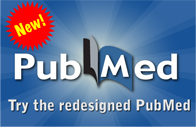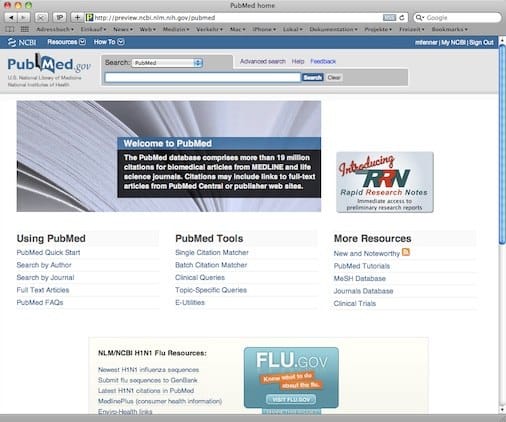It was Anna Kushnir who started it all. Frustrated with the limitations of PubMed when finishing her PhD thesis, she wrote a blog post in March 2008 (I Am Not Yelling. Not Out Loud.) about her experience. The blog post created quite a stir in the blogosphere, especially among science librarians. At the heart of the controversy was Anna's complaint that PubMed is too complicated to use, and that some science librarians felt PubMed simply is complicated and that users such as Anna should take better advantage of the resources available to better use PubMed. David Lipman, director of the NCBI and responsible for PubMed, said:
Although the current engine works well for some users and some queries, I understand Anna's frustration and we are in the midst of a number of changes that will make PubMed work better for her and many other users.
In May 2009 a PubMed redesign was shown at the 2009 Annual Meeting of the Medical Library Association (MLA) in Honolulu, and the presentation explains a lot of the ideas behind the redesign. On September 30 the redesigned PubMed was unveiled to the public, and as early as next week it will become the default PubMed web interface.

Several science bloggers have already written about the PubMed redesign, including a very detailed blog post by Jacqueline Limpens.
What is PubMed?
MEDLINE is a database of more than 19 million citations for biomedical articles, hosted by the U.S. National Library of Medicine. PubMed is the freely available Web interface to that database. Not only is the content of PubMed available from other databases (e.g. Scopus or Web of Science), but PubMed can be searched not only via the Web interface, but also from within other applications, e.g. a reference manager such as Endnote or Papers. And PubMed doesn't cover all scientific journals, many disciplines (e.g. physics, social sciences) aren't included at all. In other words, the Pubmed web interface is not the only way to find biomedical articles, and in fact will not find literature not related to the life sciences. But the PubMed web interface is probably by far the most popular way to search for biomedical literature.
What is the target audience?
The PubMed website is intended for at least 5 different audiences:
- science librarian
- researcher in the life sciences
- clinician
- patient or patient relative
- teacher, high school student, journalist and anybody else interested in life sciences research
Before PubMed was announced in June 1997 by the U.S. vice president Al Gore as free web-based access to the MEDLINE database, most users were librarians, plus of a small group of academics with paid access (remember Grateful Med ?). Now we have a number of target audiences with different experience in literature search strategies and different intentions:
- librarian vs. academic vs. the general public
- basic life sciences research vs. clinical research
As PubMed is the most popular but not the only interface to the MEDLINE database, the primary target audience will not be a librarian, but someone with less experience in searching the biomedical literature (and less time). I would lump academics together with the general public here, and think that the typical PubMed search should be as simple as the typical Google search. Everything much more complicated than a simple input box should be moved to an advanced search options page, or should be done via a different interface to the MEDLINE database.
Searching for clinical literature is very different from searching for basic science research. Here a search is often done to help in the decision making for a particular patient, and evidence-based medicine is used to find the most relevant scientific literature (with meta-analyses and randomized controlled trials providing the best evidence).

Searching for basic science literature has very different goals. It is either finding the needle in the haystack, e.g. you want to find all the published literature on the C3PO gene, or you want to find a review article as an overview over a particular field. But basic science review articles don't have the rigourous tools available to evaluate clinical research mentioned above, and here review articles only differ in the personal perspective of the reviewers and completeness and actuality of the primary literature that was covered. Searching for basic science literature should also be tightly integrated with the other databases at the NCBI. This is done via the Entrez Search Page, so that a search for C3PO also links to the organisms it was described in, e.g. this one:
I don't think that a search interface to MEDLINE can be good at both the clinical and basic science literature. The current PubMed is much closer to the latter, so I think that the primary target audience for PubMed is the academic or general public interest in basic life sciences research. A good search interface for the clinical literature would be something very different and has to include both databases of evidence-based evaluations (particularly from the Cochrane Collaboration) and from ongoing and completed clinical trials (particularly Clinicaltrials.gov, just like PubMed also hosted at the NIH).
Where is Web 2.0?
A PubMed redesign in 2009 can't be complete without looking at what Web 2.0 has to offer. This means that users should be offered a personal PubMed account that links to their libraries for full-text articles, stores common searches, creates RSS outputs, allows sharing of search results with other users, publishes a link to an interesting article on Twitter, and possibly other enhancements (e.g. a public profile page of all your PubMed articles, but that wouldn't work without author identifiers). This also means a clean design, use of Javascript/AJAX for the user interface, a version for mobile users (particularly iPhone), and frequent small updates instead of a big design change every 2-3 years.
And how is the redesigned PubMed?
After this rather long introduction, what do I like about the PubMed Redesign?
Like
- Clean, uncluttered design
- Saving a search as RSS is faster and more obvious. I hope that this will make many more people use RSS than email alerts for their regular searches (why I like RSS)
- Auto suggest: some of the most popular PubMed searches will be displayed based on the terms entered
- Some use of Javascript/AJAX
Dislike
- The DOI (the best unique identifier for a paper and the easiest way to link to the full-text article) is still not displayed in the standard abstract view (you find the DOI in the Medline and XML views)
- Small design flaw: no easy way to go back from advanced search to basic search
- Layout is now different from MyNCBI and the other NCBI databases (maybe this is work in progress)
- (As far as I know) no version for mobile users
- No send to CiteULike/Connotea/Twitter/FriendFeed, etc. buttons (popular with many journals)
The redesign will make it easier for inexperienced users to do quick searches (as mentioned above, probably the target audience). Experienced librarians might like the redesign less, as advanced searches have not become easier. But overall the changes are minor. My biggest complaint is the lack of DOI integration. A wasted opportunity. And – as mentioned above – I think we need a different MEDLINE interface for searching the clinical medicine literature.
How do you like the redesign? Jacqueline Limpens is doing a poll on her blog.


